👑 Soil Nutrients
Classification and Important Terms
Law of Limiting Factors
- Crops depend on extrinsic and intrinsic factors for their growth and environment to provide them with basic necessities for photosynthesis.
- These essential plant growth factors include:
- light 🌞
- heat 🔥
- air 🌬
- water 💦
- nutrients 🧂
- physical support 📐
- If any one factor, or combination of factors, is in limited supply, plant growth will be adversely affected. The field may contain some nutrient in excess, some in optimum and some in least, but the limiting factor for growth is the least available nutrient.
- The importance of each of the plant growth factors and the proper combination of these factors for normal plant growth is best described by the principle of limiting factors.
- This principle states:
“The level of crop production can be no greater than that allowed by the most limiting of the essential plant growth factors.”
- The
law of Minimum, stated byLiebigin 1862. The principle of limiting factors can be compared to that of a barrel having staves of different lengths with each stave representing a plant growth factor. Crop yield and quality depends upon the essential growth factors and the many interrelated soil, plant, environmental and agronomic factors or variables. Within this system, some of these factors cannot be controlled; others can be controlled and are manageable. - Soil is one of the key factors affecting plant growth as observed in the figure. The major functions of the soil are to provide plants with nutrients, water and oxygen.

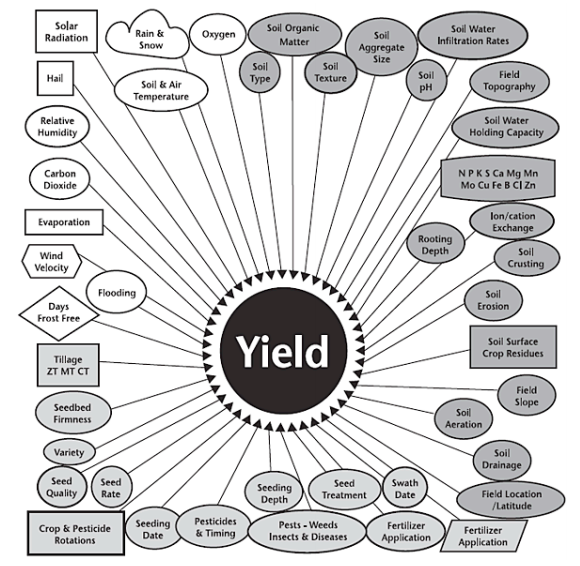
History of development of soil fertility

- Francis Bacon (1591- 1624) suggested that the principle nourishment of plants was
waterand the main purpose of the soil was to keep plants erect and to protect from heat and cold. - Jan Baptiste Van Helmont (1577 – 1644) was reported that water was sole nutrient of plants.
- Robert Boyle (1627 – 1691) an England scientist confirmed the findings of Van Helmont and proved that plant synthesis salts, spirits and oil etc. from H2O.
- Anthur Young (1741 – 1820) an English agriculturist conducted pot experiment using Barley as a test crop under sand culture condition. He added charcoal, train oil, poultry dung, spirits of wine, oster shells and numerous other materials and he conducted that some of the materials were produced higher plant growth.
- Priestly (1800) established the essentiality of O2 for the plant growth.
- J.B. Boussingault (1802-1882) French chemist conducted field experiment and maintained balance sheet. He was first scientist to conduct field experiment. He is considered as father of field experiments.
- Justus Von Liebig (1835) suggested that
- Most of the carbon in plants comes from the CO2 of the atmosphere.
- Hydrogen and O2 comes from H2O.
- Alkaline metals are needed for neutralization of acids formed by plants as a result of their metabolic activities.
- Phosphorus is necessary for seed formation.
- Plant absorb everything from the soil but excrete from their roots those materials that are not essential.
- The contributions made by Liebig to the advancement of agriculture were monumental and he is recognized as the
Father of Agricultural Chemistry. - J.B. Lawes and J. H. Gilbert (1843) established permanent manurial experiment at Rothemsted Agricultural experiment station at England. They conducted field experiments for twelve years and their findings were:
- Crop requires both P and K, but the composition of the plant ash is no measure of the amounts of these constituents required by the plant.
- No legume crop requires N and without this element, no growth will be obtained regardless of the quantities of P and K present. The amount of ammonium contributed by the atmosphere is insufficient for the needs of the crop.
- Soil fertility can be maintained for some years by chemical fertilizers.
- The beneficial effect of fallow lies in the increases in the available N compounds in the soil.
- Robert Warrington England showed that the nitrification could be supported by carbon disulphide and chloroform and that it would be stopped by adding a small amount of unsterilized soil. He demonstrated that the reaction was two step phenomenon. First NH3 being converted to nitrites and the nitrites to nitrates.
👉🏻 Basic differentiate between soil fertility and productivity:
- Soil fertility: Soil fertility is defined as the quality that enables the soil to provide proper nutrient compounds in proper amounts and in proper balance for the growth of specified plants. Soil fertility is also defined as the ability of soil to supply adequately the nutrients normally taken from the soil by plants.
- Soil Productivity: An economic concept and not a property of soil.
- All the productive soils are fertile but all the fertile soils may not be productive.
- This is due to some problems like waterlogging, alkali, saline, adverse climate etc.

- The term mineral nutrient is generally used to refer to an inorganic ion obtained from the soil and required for plant growth. The process of absorption, translocation and assimilation of nutrients by the plants is known as
mineral nutrition. - The elements C, H and O are not minerals. The rest of the elements are absorbed from the soil and these are called mineral elements since they are derived from minerals.
- Plant body contains about 30 elements and in some cases as many as 60 elements.
- These mineral elements are mainly absorbed in ionic form and to some extent in non-ionic form.
Essential Nutrients/Elements
“A mineral element is considered to be essential for plant growth and development if the element is involved in plant metabolic functions and the plant cannot complete its life cycle without the element”.
- There are
seventeenessential elements required for plant growth viz.,- C, H, O
- N, P, K
- Ca, Mg, S
- Fe, Mn
- Cu, Zn
- B, Mo
- Cl, Ni
- The following is the essentiality criteria described by
Arnon and Stout(1939) which was refined by Arnon (1954).
- A plant must be unable to complete its life cycle in the absence of the mineral element.
- The function of the element must not be replaceable by another mineral element.
- The element must be directly involved in plant metabolism.
- Recent investigations show that point (2) cannot be accepted absolutely as Mo may be substituted by vanadium (V); Similarly Cl by Br; K by Rh (Rubidium); Ca by strontium (Sr).
Beneficial Nutrients/Elements
- Beneficial elements are the mineral elements that stimulate the growth and exhibit beneficial effects at very low concentration or which are essential only for certain plant species or under specific conditions are called as “beneficial elements”.
- Eg.
Na,Va,Co,Si
Functional Nutrients
D.J. Nicholascoined the term “functional or metabolic nutrient”.- Any mineral element that functions in plant metabolism, whether or not its action is specific.
- Summation of essential and beneficial nutrients.
- 21 functional nutrients. (17 Essential + 4 Beneficial)
Essentiality of the elements established by
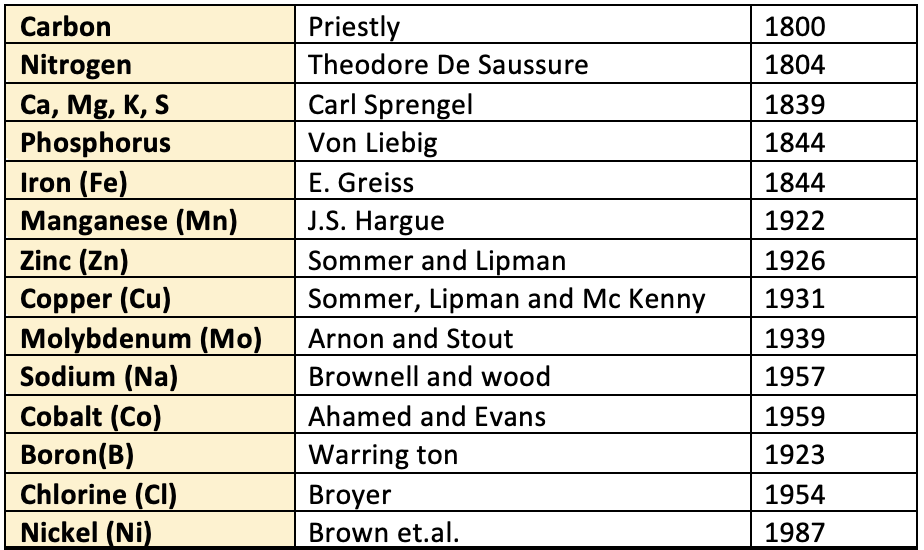
Classification of Essential Elements

- i) Basic Nutrient:
C, H, Oconstitute about 95% of the total dry matter of plants. Among them C & O constitute 45% each. - ii) Primary/ Major nutrients – are those nutrients required relatively in large quantities (> 1 ppm) by the plants for its growth and development. Eg.
N, P, K - iii) Secondary nutrients – are those nutrients which are required by plants in moderate amounts (>1ppm) and given secondary importance in its supply and management means they are indirectly applied to the soils when NPK fertilizers which contain these nutrients are used. Eg.
Ca, Mg, S - iv) Micronutrients AFO 2018 - The nutrients which are utilized by plants in relatively smaller quantities (< 1ppm). These are very efficient, and minute quantities produce optimum effects. On the other hand even a slight deficiency or excess is harmful to the plants. Eg.
Fe, Mn, Zn, Cu, B, Mo, Cl, Ni. Micronutrients are also called trace elements, Oligoelements, or Spume elements. Fe and Zn behave as macronutrients but for historical reasons, included in micronutrients.
👉🏻 2. Classification based on the role of element in plant system (According to TRUOG, 1954)
- i) Structural Elements: C, H, O (95%)
- ii) Accessory structural elements: N, P, S
- iii) Regulator & Carriers: K (Stomatal), Ca, Mg (Cell Wall)
- iv) Catalyst & Activators: Fe, Mn, Zn, Cu, B, Mo, Cl.
👉🏻 3. Metals and Non-Metals
- Non-Metals: C, H, O, N, P, S, Cl, B
- Metals: K, Ca, Mg, Fe, Mn, Zn, Cu, Mo
👉🏻 Anion/ Cation
- Cation nutrient: Ca, Mg, K, Fe, Mn, Cu, Zn, N (NH4+)
- Anion nutrient: P, B, Cl, S, Mo, N (NO3-)
👉🏻 Immobile: Ca, S, B
👉🏻 Partly Mobile: Fe, Mn, Cu, Zn, Mo
👉🏻 Mobile: N, P, K, Mg
Deficient
- When the concentration of an essential element is low enough to limit yield severely and distinct deficiency symptoms are visible then that element is said to be deficient.
- Extreme deficiencies can result in plant death. With moderate or slight deficiencies, symptoms may not be visible, but yields will still be reduced.
- Yield is severely affected when a nutrient is deficient. When deficiency is corrected, growth increases more rapidly.
- Under severe deficiency, rapid increase in growth with added nutrient can cause a small decrease in nutrient concentration due to
dilution effect. This is called theSteenberg effect.
Critical range
- The nutrient concentration in the plant below which a yield response to added nutrient occurs.
- Critical level or ranges vary among plants and nutrients but occur somewhere in the transition between nutrient deficiency and sufficiency.

Sufficient
- Concentration range in which added nutrients will not increase yield but can increase nutrient concentration.
- The term
luxury consumptionis used to describe nutrient absorption by the plant that does not influence yield. - Nutrient sufficiency occurs over a wide concentration range, wherein yield is unaffected. Increase in nutrient concentration above the critical range indicates that the plant is absorbing nutrient above that needed for maximum yield. This luxury consumption is common in most plants. Elements absorbed in excessive quantities can reduce plant yield directly through toxicity or indirectly by reducing concentration of other nutrient below critical ranges.
Excessive or toxic
- When the concentration of essential or other elements is high enough to reduce plant growth and yield then it is said to be toxic.
- Excessive nutrient concentration can cause an imbalance in other essential nutrients, which also can reduce yield.
Hidden Hunger
- The term Hidden Hunger is used to describe a plant that
shows no obvious symptomsyet the nutrient content is sufficient to give the top profitable yield. - Fertilization with the sure rate rather than bare economic optimum for on average yield helps to detain the top profitable.
- Sure rate is a rate a little above critical limit to be sure that there is no reduction in yield.
- The Hidden Hunger is an expression in Soil Science to designate a condition in plants brought about through the lack of certain essential elements in the soil and is not easily detected by outward appearance.
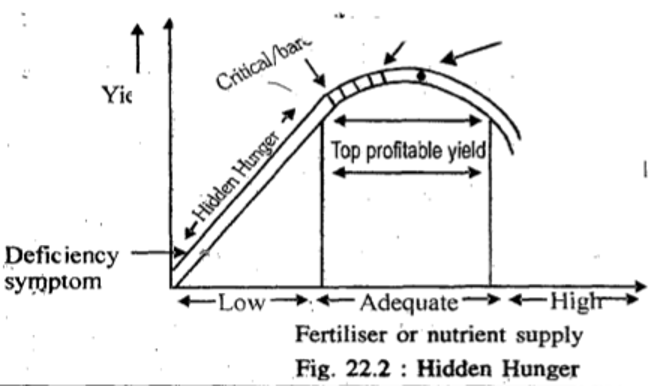
Forms of nutrients absorbed by Plants
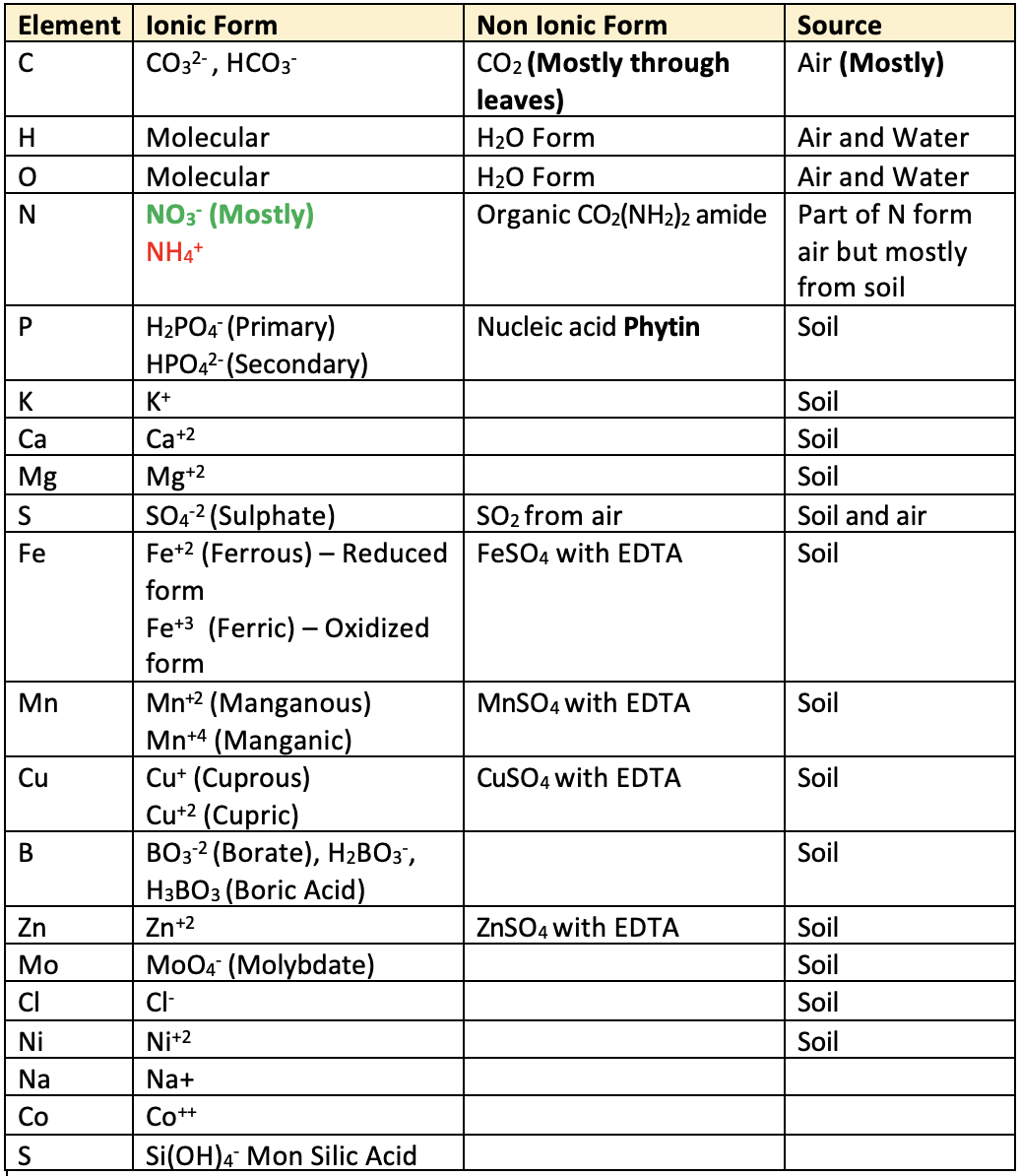
Available Nutrient analysis of soil
-
For analyzing available nutrients, first available nutrients are extracted by using reagent known as extracting reagent.
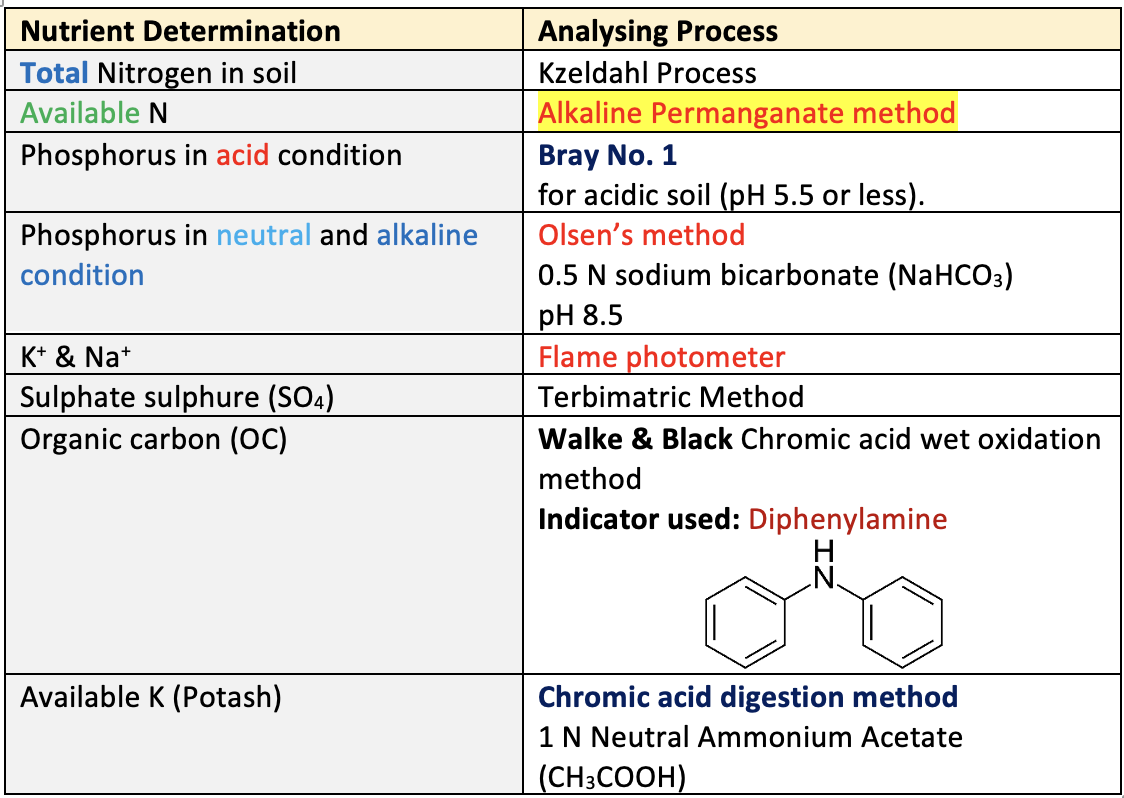
-
After exctraction nutrients, actual amount of available nutrient is determined by colourimetric method.
-
On the basis of analysis of available nutrients, soil fertility is classified broadly into 3 groups viz. low, medium and high.

Crop Logging
- Defined by H.F. Clement: “The crop log is the graphic record of the progress of the crop, contains a series of chemical and physical measurements. These measurements indicate the general condition of the plant and suggest the changes in management that are necessary to produce maximum yield.
- Crop logging is used for
sugarcanefirst time inHawai. - Crop logging is a record of composition of crop, with respect to N.P.K., moisture, sugar and weight of young sheath tissue, and other management at regular intervals during crop growth in the field. From a knowledge of nutrient status, additional nutrient requirements of the sugarcane crop are assessed and necessary application of fertilizer is made. So is the case with moisture status and irrigation.
Nutrient mobility concepts
- Given by Bray
Plants used for nutrient deficiency indicator
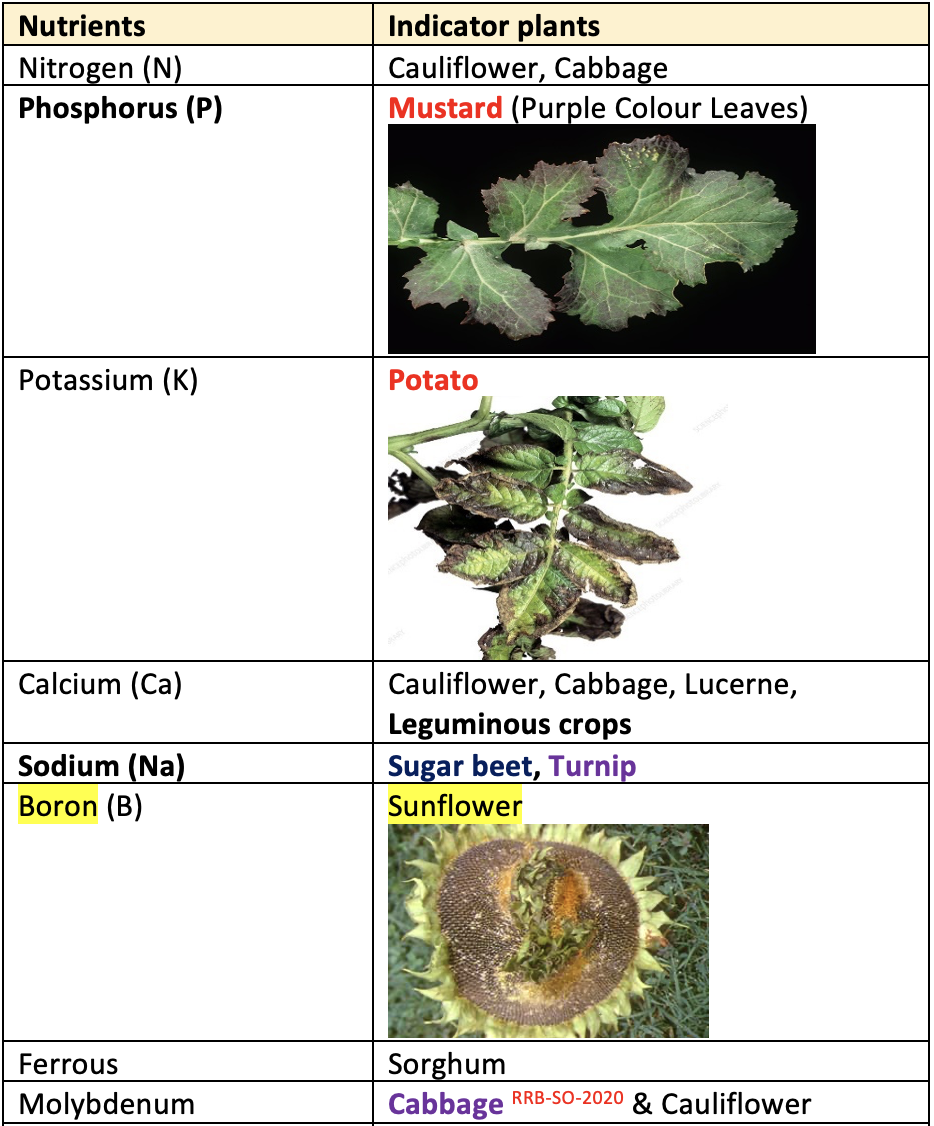

Deficiency Symptoms
AFO 2017
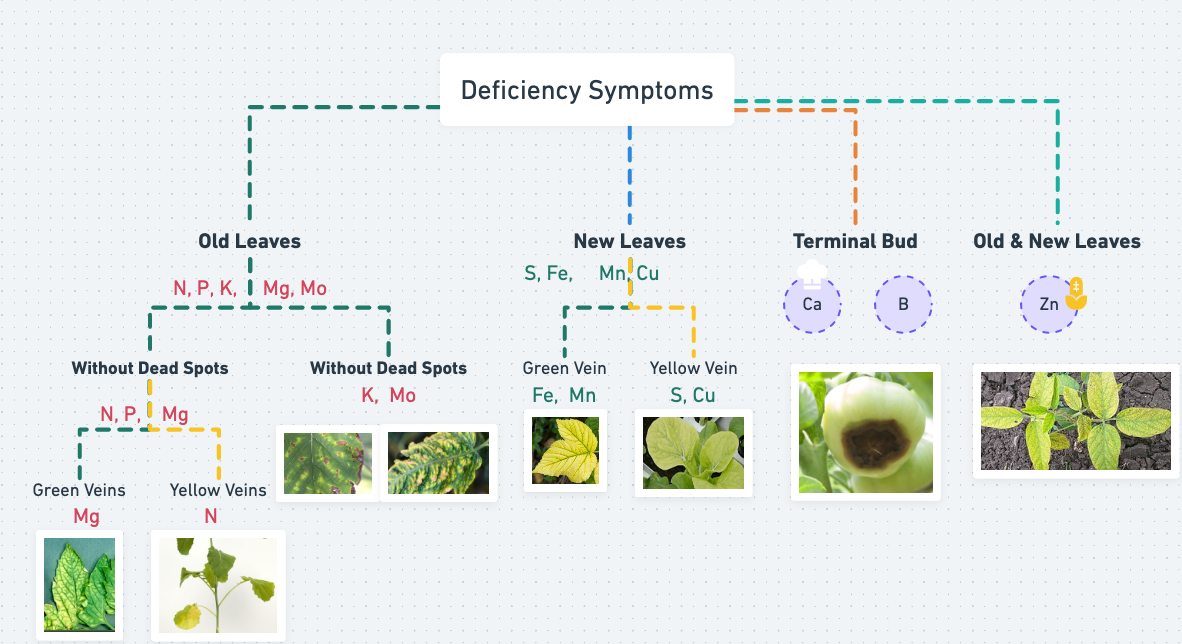
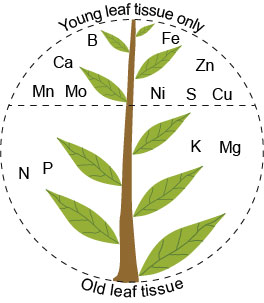
- The actively growing parts of plants are the priority for plants.
- If a nutrient is immobile, its deficiency will manifest in young leaves since it cannot be moved from older to newer growth.
- Conversely, if a nutrient is mobile, it will be relocated to the growing areas during a deficiency, causing symptoms to appear in older plant parts.
References
Law of Limiting Factors
- Crops depend on extrinsic and intrinsic factors for their growth and environment to provide them with basic necessities for photosynthesis.
- These essential plant growth factors include:
- light 🌞
- heat 🔥
- air 🌬
- water 💦
- nutrients 🧂
- physical support 📐
- If any one factor, or combination of factors, is in limited supply, plant growth will be adversely affected. The field may contain some nutrient in excess, some in optimum and some in least, but the limiting factor for growth is the least available nutrient.
- The importance of each of the plant growth factors and the proper combination of these factors for normal plant growth is best described by the principle of limiting factors.
- This principle states:
“The level of crop production can be no greater than that …
Become Successful With AgriDots
Learn the essential skills for getting a seat in the Exam with
🦄 You are a pro member!
Only use this page if purchasing a gift or enterprise account
Plan
- Unlimited access to PRO courses
- Quizzes with hand-picked meme prizes
- Invite to private Discord chat
- Free Sticker emailed
Lifetime
- All PRO-tier benefits
- Single payment, lifetime access
- 4,200 bonus xp points
- Next Level
T-shirt shipped worldwide

Yo! You just found a 20% discount using 👉 EASTEREGG

High-quality fitted cotton shirt produced by Next Level Apparel